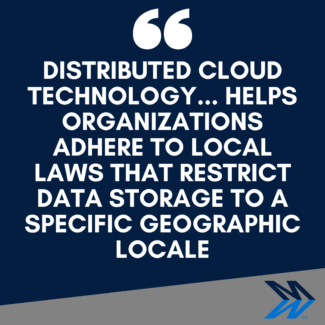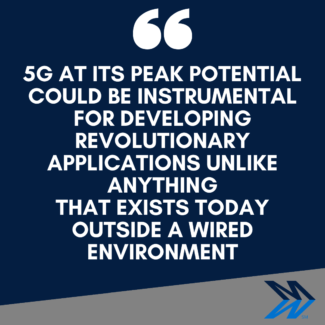December 16, 2020
Seemingly omnipresent and increasingly omniscient, technology impacts virtually every facet of life and work in most of the world. And with each passing year, it gets faster, smarter and more all-encompassing. Mindsight’s picks for Top Tech of 2021 are no exception. From IoT connectivity to data security and beyond, here are some key developments to watch for.
Distributed Cloud
 It’s basically what it appears to be: the distribution of various public cloud services (Saas, PaaS, etc.) to different physical locations. Is it new? No. But it’s growing, and quickly. According to Gartner, besides reducing data costs and solving low-latency issues, distributed cloud technology also helps organizations adhere to local laws that restrict data storage to a specific geographic locale. And it’s a boon from a maintenance perspective in that operation and governance remain centralized with the public cloud provider. As Gartner notes, DC will evolve in two phases: 1) as a “like-for-like hybrid, where enterprise customers will buy cloud substations to mimic the promise of hybrid cloud and avoid latency-based problems”; and 2) the purchasing and opening of cloud substations by utilities, universities, city governments and telcos, among others.
It’s basically what it appears to be: the distribution of various public cloud services (Saas, PaaS, etc.) to different physical locations. Is it new? No. But it’s growing, and quickly. According to Gartner, besides reducing data costs and solving low-latency issues, distributed cloud technology also helps organizations adhere to local laws that restrict data storage to a specific geographic locale. And it’s a boon from a maintenance perspective in that operation and governance remain centralized with the public cloud provider. As Gartner notes, DC will evolve in two phases: 1) as a “like-for-like hybrid, where enterprise customers will buy cloud substations to mimic the promise of hybrid cloud and avoid latency-based problems”; and 2) the purchasing and opening of cloud substations by utilities, universities, city governments and telcos, among others.
Bigger impact of IoT
Connectivity is key these days, and it will only become more central in the months and years to come. From smart cities and smart stores to smarter manufacturing and healthcare, the IoT revolution continues to mesh the traditional and the technological to enhance products and services. Machinery that’s latched into the web can be monitored for preventative maintenance. Forklift operators can better navigate factory floors. Healthcare professionals can more accurately monitor patients via wearable sensors. Cities can become eco-friendlier by optimizing traffic and electricity consumption. Stores can offer a more personalized shopping experience by tracking shoppers’ movements and displaying certain items based on known preferences. Not all of that is perfected yet, but it likely will be soon.
As-a-Service
More commonly known as XaaS, it means customers can gain access to a wide array of things — from software and devices to AI and security — without having to purchase any physical products. The products are the service. Benefits include up-scaling and down-scaling on short notice, as well as more insight into customer purchasing. And there’s less waste, because customers use only the products they need when they need them. A win-win on both ends, XaaS is the future of, well, just about everything. But don’t get carried away. “By getting too excited with all the new services available, companies will find that Anything-as-a-Service becomes Anything-as-a-Mess,” analyst and digital marketing CEO Daniel Newman warned in Forbes. “A solid vision, tech strategy, and customer engagement plan should always accompany an XaaS trial or subscription — there is no substitute or replacement for good old-fashioned common sense and compatibility.”
AI/Machine Learning-improved Cybersecurity
Before AI becomes sentient and obliterates humanity, it will also help keep us safer. In the case of enhanced cybersecurity, AI subset machine learning is employed to make systems less vulnerable and security measures more cost-effective. It also helps fill labor gaps caused by a shortage of human experts. In a recent article for Ciso Magazine, tech analyst Kashyap Kompella noted that while supervised machine learning is now the most common way to train systems, “unsupervised learning use cases are still in an emerging phase and experimentation.” He also enumerated an array of applications, including intrusion detection, malware detection, discovery of code vulnerabilities, enhanced threat intelligence, and fraud detection. And while those applications aren’t new, AI can make them faster and more robust. But to implement AI successfully, the Capgemini Research Institute recently advised, companies need to “build a roadmap” for doing so. “This means identifying data sources and creating data platforms to operationalize AI, selecting the right use cases to accelerate and maximize benefits, collaborating externally to enhance threat intelligence, deploying security, orchestration, automation, and response (SOAR) to improve security management, training cyber analysts to be AI-ready, and installing governance for AI in cybersecurity to deliver long-term improvement.”
Expansion of 5G
 Yes, it can greatly improve cell phone reception, enhance video streaming and supercharge your online gaming experience by reducing latency. But 5G is about far more than personal amusement and communication. Here’s one example: real-time automation. That’s nearly impossible with slower connection speeds (like the still-ubiquitous 4G) considering all the information from Big Data repositories that needs to be hoovered up and parsed before it’s of any use in cybersecurity, manufacturing and countless other sectors. Central to ushering in what’s been called the Fourth Industrial Revolution, perfected and widely available 5G will greatly augment the ongoing IoT explosion and facilitate technological discoveries we can’t yet fathom. As IBM puts it, “5G at its peak potential could be instrumental for developing revolutionary applications unlike anything that exists today outside a wired environment. These applications are varied, but there is predicted growth in fields like autonomous driving, virtual reality, and augmented reality. Beyond speed and latency, 5G standards will have a much higher connection density, allowing networks to handle immense numbers of connected devices.” Is it without risks? No. But revolutionary developments rarely are.
Yes, it can greatly improve cell phone reception, enhance video streaming and supercharge your online gaming experience by reducing latency. But 5G is about far more than personal amusement and communication. Here’s one example: real-time automation. That’s nearly impossible with slower connection speeds (like the still-ubiquitous 4G) considering all the information from Big Data repositories that needs to be hoovered up and parsed before it’s of any use in cybersecurity, manufacturing and countless other sectors. Central to ushering in what’s been called the Fourth Industrial Revolution, perfected and widely available 5G will greatly augment the ongoing IoT explosion and facilitate technological discoveries we can’t yet fathom. As IBM puts it, “5G at its peak potential could be instrumental for developing revolutionary applications unlike anything that exists today outside a wired environment. These applications are varied, but there is predicted growth in fields like autonomous driving, virtual reality, and augmented reality. Beyond speed and latency, 5G standards will have a much higher connection density, allowing networks to handle immense numbers of connected devices.” Is it without risks? No. But revolutionary developments rarely are.
Hyperautomation
At the start of 2020, Gartner predicted that 69% of “routine work” would be automated by 2024. It also coined a new term for this evolving process: Hyperautomation — end-to-end automation guided by a single intelligence system. Employing AI, advanced analytics, Robotic Process Automation (RPM) and Intelligent Business Process Automation (iBPM), it relieves human workers of repetitive and low-value tasks so they can focus on ones that require more creativity and complex cognition. “The role of manager will see a complete overhaul in the next four years,” Gartner research VP Helen Poitevin said early this year. “Currently, managers often need to spend time filling in forms, updating information and approving workflows. By using AI to automate these tasks, they can spend less time managing transactions and can invest more time on learning, performance management and goal setting.” Complemented by human intelligence and a boon to productivity, hyperautomation also simplifies data sharing, speeds up data retrieval, and provides a real-time view of what’s happening in every division across an entire enterprise.
So as we ring out the old (good riddance, 2020!) and ring in the new (fingers crossed), keep these revolutionary tech advancements on your radar. Not that you have a choice. Like pizza and the common cold, they’re here to stay.
About Mindsight
Mindsight, a Chicago IT services provider, is an extension of your team. Our culture is built on transparency and trust, and our team is made up of extraordinary people – the kinds of people you would hire. We have one of the largest expert-level engineering teams delivering the full spectrum of IT services and solutions, from cloud to infrastructure, collaboration to contact center. Our customers rely on our thought leadership, responsiveness, and dedication to solving their toughest technology challenges.
Contact us at GoMindsight.com.

